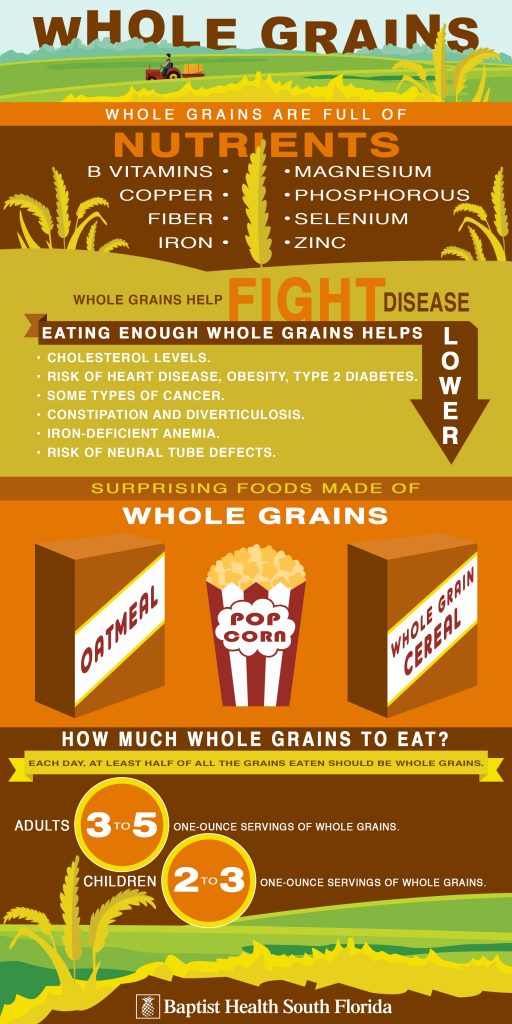March 23, 2020 by Amy Kimberlain
The Benefits of Eating Whole Grains (Infographic)

Americans are eating more whole grains, and that’s a good thing. About two-thirds of adults in the U.S. say they eat the recommended amount of whole grains each day – about 6 ounces – according to the Whole Grains Council.
The Council sponsors Whole Grain Month in September to raise awareness.
Recent research shows that eating whole grains can reduce heart disease, prevent some types of cancer and help with weight management. Awareness of these benefits is contributing to the rise in consumption.
“Whole grains have a lot of nutrients that are important to many aspects of a healthy body, including a strong immune system and bones,” said Melissa Franco, D.O., a Baptist Health Primary Care physician. “They also provide the body with a good amount of fiber which can help people lose weight and prevent constipation.”
Whole grains are easy to find but checking labels is important.
“Stock up on brown rice, wild rice, barley, oats, quinoa, whole wheat pasta and whole wheat bread,” says Alice Pereira, a registered dietitian with Baptist Health South Florida. “And pay careful attention to food labels. Make sure you check the ingredients list for the word whole or whole grains.”
A whole grain is a grain in its natural state – the whole seed, or kernel, of the grain. Whole grains have more nutrients than refined grains, which consist of a seed stripped of one or more its layers.
Tips to Help You Eat Whole Grains
- Substitute a whole-grain product for a refined product – such as eating whole-wheat bread instead of white bread.
- Try brown rice or whole-wheat pasta. Brown rice stuffing in baked peppers or tomatoes and whole-wheat macaroni in macaroni and cheese make tasty meals.
- Use whole grains in mixed dishes, such as barley in vegetable soup or stews and bulgur wheat in a casserole or stir-fry.
- Create a whole grain pilaf with a mixture of barley, wild rice, brown rice, broth and spices. For a special touch, stir in toasted nuts or chopped dried fruit.
- Substitute whole wheat or oat flour for up to half of the flour in pancake, waffle, muffin or other flour-based recipe.
- Use whole-grain bread or cracker crumbs in meatloaf.
- Try rolled oats or a crushed, unsweetened whole grain cereal as breading for baked chicken, fish, veal cutlets, or eggplant parmesan.
- Try an unsweetened, whole grain ready-to-eat cereal as croutons in salad or in place of crackers with soup.
- Freeze leftover cooked brown rice, bulgur, or barley. Heat and serve it later as a quick side dish.

top stories












There are no comments